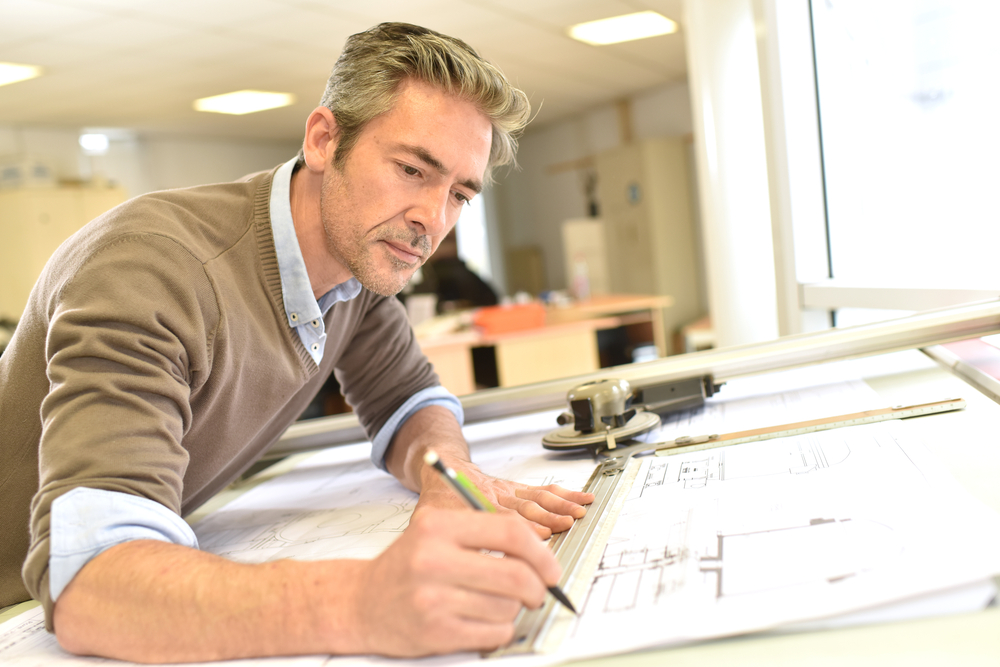Architect Salary Report by Region and Seniority
Architect Salary Report by Region and Seniority
Blog Article
Comprehending the Diverse Job Paths Available for Aspiring Architect
As an ambitious Architect, you have a world of occupation courses waiting for you. Whether you're attracted to conventional design or the subtleties of sustainable layout, there's a specific niche that straightens with your rate of interests.
Standard Architecture: Designing Structures and Frameworks
Traditional design concentrates on making structures and structures that mix performance with aesthetic appeal. As you discover this area, you'll appreciate the intricate equilibrium between kind and function. You'll learn to draw inspiration from historic designs, incorporating components like symmetry, products, and craftsmanship. Your styles can mirror social heritage, showcasing regional customs while satisfying contemporary demands.
You'll establish skills in composing, model-making, and website analysis, allowing you to envision and communicate your ideas properly. Engaging with customers, you'll require to comprehend their vision and equate it right into feasible layouts.
Moreover, building codes and sustainability methods are important in your job, ensuring your structures are safe and eco-friendly. As you expand in your profession, you'll find chances in property, commercial, and even restoration jobs, each offering one-of-a-kind challenges. Welcoming standard style leads the way for a satisfying job that pays homage to the past while forming the future.
Urban Planning: Forming Areas and Public Spaces
As an ambitious Architect, you can play an important duty as a city organizer, changing how communities work and engage. By employing neighborhood interaction approaches, you'll guarantee that residents have a voice fit their environment. And also, integrating lasting style concepts will certainly aid create rooms that not only fulfill today's needs however additionally secure the future.
Role of Urban Planners
While lots of might consider engineers as the sole enthusiasts behind structures, metropolitan planners play an essential function fit the wider landscape of areas and public areas. They examine land usage, zoning regulations, and neighborhood needs to develop lasting environments that enhance high quality of life. By teaming up with numerous stakeholders, you'll assist make parks, transport systems, and houses that promote social interaction and access. Urban coordinators likewise concentrate on environmental factors to consider, ensuring that growths integrate environment-friendly spaces and support biodiversity. Your competence in spatial style and community dynamics permits you to envision future growth while preserving social heritage. In this critical function, you'll directly influence exactly how individuals experience their surroundings, making every task an opportunity for favorable modification.
Community Involvement Methods
Efficient area involvement techniques are vital for urban coordinators to guarantee that the voices of residents are listened to and valued in the planning procedure. To foster meaningful dialogue, you should focus on open online forums and workshops where area members can share their ideas and problems. Use surveys and social media to reach a wider target market, making sure diverse perspectives are included. Teaming up with neighborhood companies can boost trust fund and facilitate deeper links. It is necessary to offer clear details concerning suggested projects and decision-making procedures, allowing citizens to really feel informed and equipped. By actively paying attention and incorporating feedback, you'll develop rooms that mirror the community's requirements, ultimately causing even more successful and lasting metropolitan environments. Accept openness and constant discussion for long lasting influence.
Sustainable Design Concepts
When making metropolitan areas, including lasting layout concepts is vital for developing settings that thrive both environmentally and socially. You should begin by focusing on energy efficiency, utilizing products that decrease waste and advertise recycling. Consider incorporating eco-friendly spaces, like yards and parks, to boost biodiversity and boost air high quality. Advertising walkability and public transport can minimize dependence on automobiles, promoting a healthier neighborhood.
Designing with water conservation in mind is additionally crucial-- think regarding rainfall gardens and permeable surface areas to manage stormwater. Entailing community members during the preparation procedure assurances that the areas you develop satisfy their demands and encourage social communication. By welcoming these concepts, you'll add to dynamic, sustainable metropolitan landscapes that benefit everyone.

Landscape Architecture: Creating Sustainable Exterior Settings
As you check out landscape style, you'll discover necessary style concepts that develop beautiful and useful outdoor rooms. Lasting techniques play an important role in making certain these settings thrive while reducing ecological influence. Plus, you'll discover a selection of job possibilities that enable you to make an actual distinction in just how individuals communicate with nature.
Style Concepts in Landscape
Understanding layout concepts in landscape style is important for developing lasting outside settings that harmonize with nature. You'll need to ponder components like percentage, scale, and balance to guarantee your styles really feel natural and inviting. In addition, pay attention to seasonal changes, making with materials that enhance the surroundings year-round.
Sustainable Practices Introduction
Sustainable practices in landscape design not only concentrate on looks yet additionally prioritize ecological health and resource conservation. By integrating native plants, you enhance biodiversity and lower the demand for chemical fertilizers and chemicals. Carrying out effective irrigation systems assists conserve water and decreases overflow, shielding neighboring ecosystems. You can create rooms that promote dirt wellness, such as making use of natural products and exercising permaculture principles. In addition, including environment-friendly framework, like rain yards and permeable pavements, help in stormwater monitoring and lowers urban warmth. When you develop outside atmospheres with sustainability in mind, you add to a much healthier world and give rooms that promote neighborhood link. Eventually, these techniques guarantee your layouts benefit both people and the setting for many years to come.
Job Opportunities Exploration
With a strong structure in lasting techniques, landscape design provides a variety of profession courses that enable you to make a meaningful influence on the atmosphere. You can work as a landscape developer, creating cosmetically pleasing and practical outside rooms, or concentrate on eco-friendly remediation, helping to revitalize broken ecological communities. Urban coordinators frequently collaborate with landscape architects to create eco-friendly areas in metropolitan settings, enhancing city livability. If you're enthusiastic regarding education and learning, take into consideration ending up being a landscape architecture teacher, inspiring future generations. Additionally, you could deal with nonprofits concentrated on ecological sustainability or take part in research to innovate new methods. Each path not only forms stunning environments but also promotes a healthier planet for future generations.
Sustainable Design: Concentrating On Eco-Friendly Practices
As you discover your profession in architecture, accepting eco-friendly techniques can set you apart in a read the article competitive area. Lasting design concentrates on creating buildings that lessen ecological impact while boosting occupant well-being. By integrating eco-friendly materials, energy-efficient systems, and lasting structure methods, you'll add to a greener future.
Start by obtaining understanding of green accreditations like LEED or BREEAM, which can reinforce your qualifications. Consider exactly how natural light, air flow, and thermal performance can maximize style. Team up with engineers and environmental experts to introduce services that reduce waste and conserve resources.
Don't neglect the importance of community involvement-- engaging local stakeholders can motivate layouts that balance with the environment. As clients significantly prioritize sustainability, your knowledge in green techniques will not just draw in jobs yet likewise satisfy your passion for liable design. Welcome this important facet of the career, and enjoy your profession grow.
Historical Conservation: Shielding and Recovering Social Heritage
While you commence on your building trip, consider the important role of historic preservation in keeping our social heritage. This area concentrates on the defense and restoration of substantial buildings, sites, and structures that inform the tales of our past. By participating in historical conservation, you'll aid secure the architectural tradition that forms area identification.
As a historical conservation Architect, you'll examine historical significance and analyze the problem of structures. You'll function carefully with conservationists and chroniclers to guarantee genuine repair strategies are used. This career path allows you to blend creativity with research, enabling you to design remedies that appreciate original materials and craftsmanship.
Your work not only adds to sustainability by recycling existing buildings yet likewise fosters a feeling of pride within areas. Embracing this course will certainly assist you become a go to this site guardian of background, preserving the stories and visual appeals that improve our lives.
Inside Style: Enhancing Indoor Spaces
Historic preservation and interior design both share a commitment to boosting the built environment, yet they concentrate on various elements. While historic conservation stresses preserving a framework's social and historical value, indoor style nos in on maximizing indoor rooms for capability and aesthetic appeals.
As an ambitious Architect, you'll find that indoor style permits you to mix creativity with technological abilities. You'll develop spaces that not just look good but additionally advertise comfort and effectiveness. This area involves recognizing how light, shade, and materials interact within a space, impacting state of mind and use.
You'll function on numerous projects, from property homes to commercial offices, making certain that each atmosphere satisfies the needs of its residents. By prioritizing user experience, you can change insides into functional and motivating areas, making a considerable influence on exactly how people connect with their environments. Embrace the chance to enhance interior atmospheres and shape the method individuals work and live.
Industrial Style: Merging Performance With Appearances
Commercial design plays a vital function in developing items that flawlessly mix appearances with capability, guaranteeing that what you utilize day-to-day is not only aesthetically attractive but additionally useful. As a hopeful Architect, you might involve yourself in this area, concentrating on making whatever from furnishings to customer electronics. Your work entails comprehending user needs, products, and producing processes, allowing you to produce ingenious services that enhance everyday experiences.
In commercial design, you'll frequently team up with marketers, designers, and suppliers, guaranteeing that your styles are not just beautiful yet also possible. This profession course uses a dynamic environment where creative thinking satisfies practicality, making it a gratifying choice for designers interested in shaping the products of tomorrow.
Often Asked Questions
What Educational Credentials Do I Required to Come To Be a Designer?
To become an architect, you'll require a specialist level in architecture, generally a Bachelor's or Master's. Additionally, you'll need to finish a teaching fellowship and pass the Architect Registration Examination to exercise legally.
Exist Qualification Requirements for Various Architectural Career Paths?
Yes, there're certification demands for numerous architectural courses. Architect. You'll require to pass exams, complete teaching fellowships, and sometimes pursue specialized training, relying on your selected focus, like landscape architecture, city style, or historical preservation
What Software Application Abilities Are Crucial for Designers Today?

How Can I Gain Practical Experience While Examining Design?
You can acquire practical experience by interning at building firms, joining layout competitors, offering for area projects, or teaming up with schoolmates on real-world assignments. These chances enhance your abilities and construct valuable links in the sector.
What Task Opportunities Exist Outdoors Standard Style Firms?
You can check out different task opportunities outside conventional design companies, like urban planning, indoor design, landscape architecture, building and construction management, property development, click here to read or even functions in sustainability consulting. Each offers unique challenges and benefits.
Whether you're drawn to traditional style or the nuances of sustainable layout, there's a niche that aligns with your interests.When developing city spaces, including sustainable layout principles is essential for developing environments that thrive both environmentally and socially.As you explore landscape style, you'll find important style concepts that produce useful and stunning outdoor rooms.Comprehending layout concepts in landscape design is vital for developing sustainable outside atmospheres that integrate with nature.In industrial design, you'll frequently collaborate with producers, designers, and marketers, making certain that your styles are not only stunning but additionally possible.
Report this page